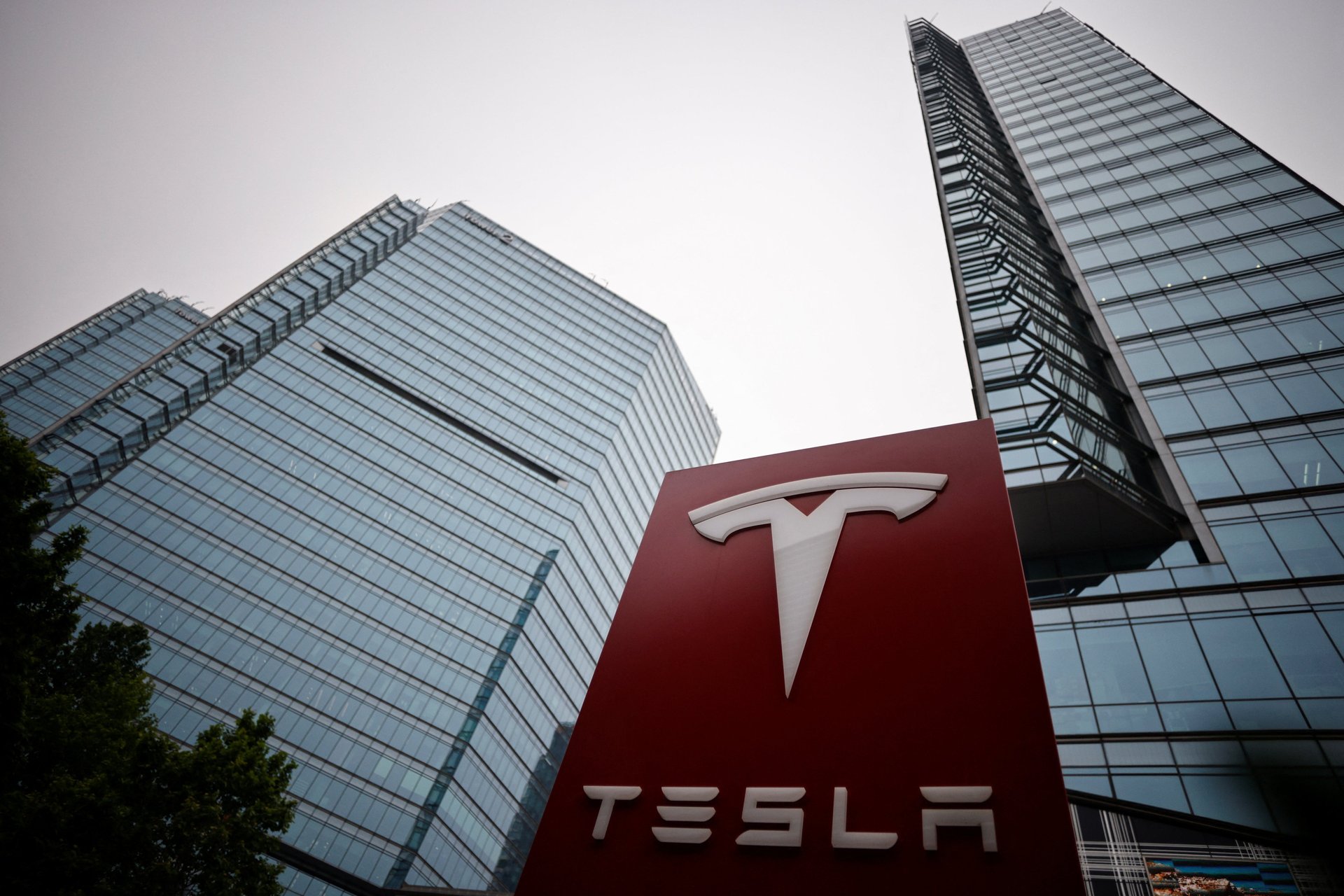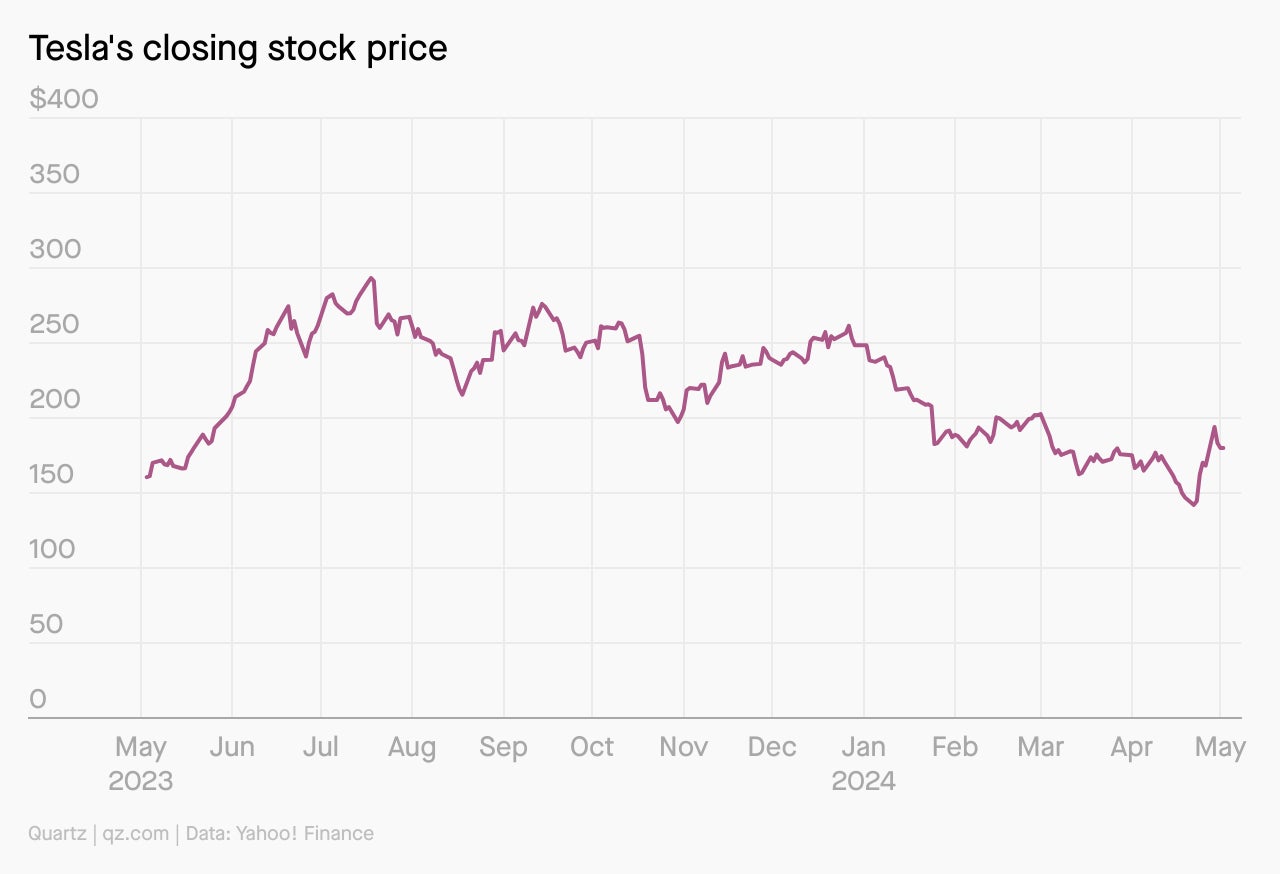Elon Musk's rare good week
What is the market seeing in Tesla that the news headlines aren't?


Hi, Quartz members!
For much of this year, on the S&P 500, few stocks had fared as badly as Tesla. Among them was Boeing, a plane company whose planes are actually falling apart. There seemed to be no worse indictment of the kind of year Elon Musk and his EV company were fated to have.
This past week, Musk laid off most of Tesla’s Supercharger team, who have engineered the network of EV charging stations around the US. Then he scrapped Tesla’s gigacasting manufacturing process, in which giant presses and molds fabricated the underbody of a car in one single piece. Several executives quit. Last month, Tesla had announced plans to lay off 10% of its workforce, not long after it revealed that it had delivered a fifth fewer cars than the previous quarter. It was a cavalcade of dire news.
Unexpectedly, though, over the last ten days or so, the worm of Tesla’s stock ticker has lifted its head. Within that period, or thereabouts, the stock went from the $140-odd doldrums to $194. (It suffered a slight dip thereafter.) It’s all still a long way from the heady days of late 2021, when the stock price surpassed $400, but the recent buoyancy is intriguing. What is the market seeing in Tesla that the headlines aren’t?
CHARTED

THE CHINA SYNDROME
The most notable recent rise in Tesla’s stock price came this past week, after Musk returned from a swift trip to Beijing. China is Tesla’s second-biggest market after the US, and authorities there gave the company tentative permission to deploy its advanced driver-assistance feature, called “full self-driving,” in the country.
For Tesla, this is important. Other homegrown auto makers in China already offer such features, and Tesla’s sales in China had shrunk by 4% last quarter, as compared to a year earlier, even as the EV market overall is booming.
This development won’t just help Tesla compete in one of the world’s most lucrative markets. It also aligns the company more closely with Musk’s own vision for it. At the heart of Tesla’s future, he believes, are robotaxis, or what he calls “cybercabs.” These cars, when not in use by their owners, can pick up and drop other passengers, much as Ubers do today. “The economics of the system are just insanely positive,” Musk said last year.
And he isn’t deterred by the technological challenges of building such a vehicle. In Tesla’s first-quarter earnings call, Musk said: “If somebody doesn’t believe Tesla is going to solve autonomy, I think they should not be an investor in the company.” Rolling out “full self-driving” in China is nothing like building a robotaxi. But it’s a step in the direction that Musk wants Tesla to take.
A CHEAPER TESLA
Tesla’s strategy of coping with high inventories has, thus far, been to offer deep discounts in order to shift its stock. In the first quarter, the company added more than 46,000 vehicles to its global inventory. Discounts ensued. But what this repeated cycle is really indicative of is: The market still thinks of Teslas as too expensive.
Early in April, Reuters reported that Tesla was planning to cancel its so-called inexpensive model, a car that would begin at around $25,000, compared to the Model 3's price tag in the vicinity of $39,000. Shares fell after Reuters published its exclusive. But a few weeks later, Tesla put cheaper cars back on its agenda, announcing that they would roll out in 2025, if not earlier. Musk didn’t offer any more details at the time, although he had said earlier that the cheaper Model 2 would need all-new manufacturing facilities in Texas and Mexico.
That sent Tesla’s stock up as well. In January, China’s BYD had overtaken Tesla as the world’s best-selling EV maker, selling 526,000 battery-only cars to Tesla’s 484,000 in the last quarter of 2023. One of the cheapest and most popular of BYD’s cars, the Seagull, retails at under $10,000 in China. If Tesla needs to remain competitive, it has to find ways to sell more cars, which is possible only if they’re cheaper. Sure, Musk could have been far more concrete about the Model 2, as investors complained. But recommitting even vaguely to some version of an inexpensive Tesla was Musk’s signal that he recognizes the ground truth of price.
ONE 🔌 THING
Musk’s decision to drastically scale back his Supercharger team is a head-scratcher, though. As of date, Tesla’s charging standard offers 8% of all global EV charging capacity, according to BloombergNEF. “On a global basis, it has more than 57,000 Superchargers, which generated $1.74 billion of charging revenue in 2023,” Quartz’s Will Gavin wrote. “That’s about 1.5% of total revenue for the year and 17% of Tesla’s ‘Services & Other’ segment.”
More importantly, Tesla had a shot at making its Supercharger the industry standard. At least a dozen other Western automakers have signed on to build cars that will dock into Superchargers, and Tesla has won millions of dollars in US government grants to build out its network. It has committed to doubling the size of its network by the end of this year, and one estimate reckoned that Tesla could earn up to $12 billion in annual charging revenue by 2030 by further opening up its charging stations to non-Teslas. The network alone could be worth $100 billion.
Part of Musk’s reason for sacking so many Supercharger personnel is his stated intention to be “absolutely hardcore about headcount.” But Musk being Musk, it’s natural to wonder if there’s an element of dudgeon in here: resentment that Tesla’s Supercharger investments will end up helping the EV efforts of other carmakers, and obstinacy that these carmakers can just solve their charging problems on their own.
Thanks for reading! And don’t hesitate to reach out with comments, questions, or topics you want to know more about.
Have a supercharged weekend!
— Samanth Subramanian, Weekend Brief editor